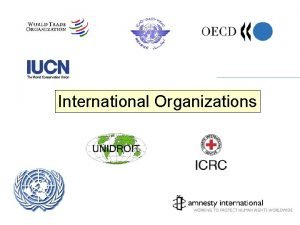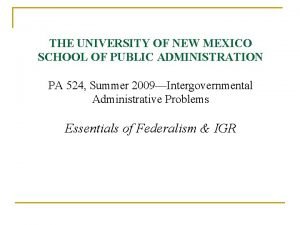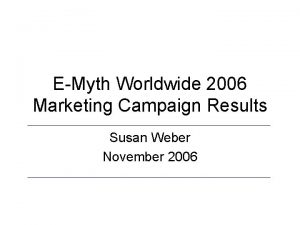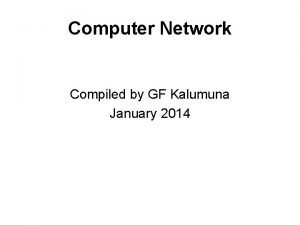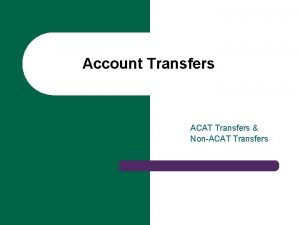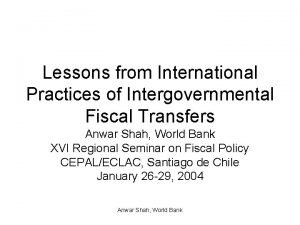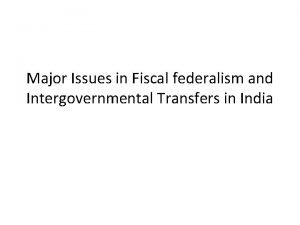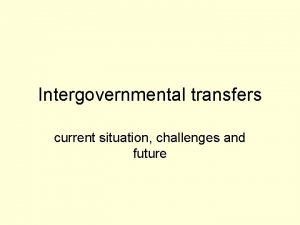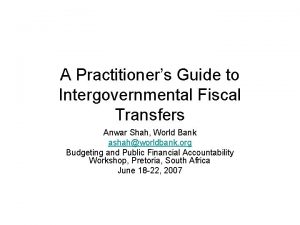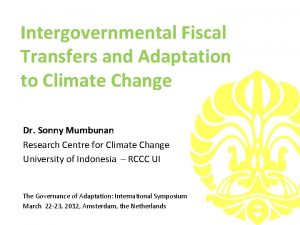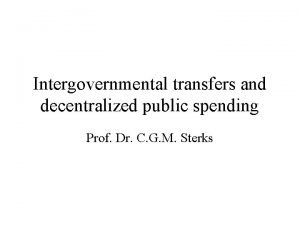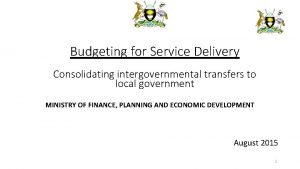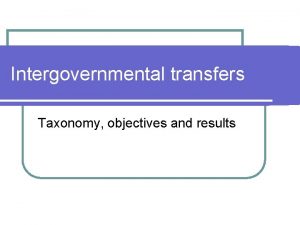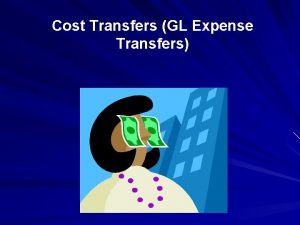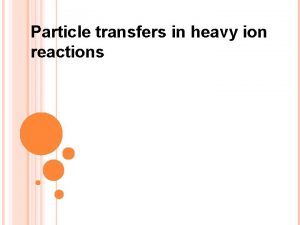Lessons From Worldwide Practices of Intergovernmental Fiscal Transfers








































- Slides: 40

Lessons From Worldwide Practices of Intergovernmental Fiscal Transfers Anwar Shah (shah. anwar@gmail. com), Brookings Institution and the World Bank, Washington, DC The 1 st Asian Public Governance Forum on Local Finance Management Lombok, Indonesia 7 -8 May 2015

Intergovernmental Government Fiscal Transfers (IGFT) Outline • Guidelines for grant design • A Summary View of Grant Design • Revenue Sharing Transfers • Equalization Transfers • Results Based Intergovernmental Finance Shah. The Practice of Intergovernmental Fiscal Transfers 2

Guidelines for Intergovernmental Finance • Clarity in objectives, consistency of design with objectives and singular focus • Simplicity, objectivity and transparency of allocation criteria • Incentives for fiscal prudence and competitive service delivery and results based accountability to citizens • Autonomy: Independence in designing programs and flexibility in use of resources • Revenue Adequacy and responsiveness • Predictability • Fairness: entitlements vary inversely with fiscal capacity and directly with fiscal needs; one size does not fit all – urban vs. rural, large vs. small • Affordability • Review: Sunset clauses to ensure periodic review and assessment Shah. The Practice of Intergovernmental Fiscal Transfers 3

Objective Grant Design Better Practices to Avoid Bridging vertical fiscal gaps Reassign, tax base sharing Canada Deficit grants, (China), tax by tax sharing (China, India pre-2000) Reducing regional fiscal disparities (equalization) Fiscal capacity equalization (FCE) Fiscal capacity equalization with an explicit standard as in Canada, Germany, Denmark, Finland General revenue sharing with multiple factors, (Brazil, India) Fiscal equalization with a fixed pool as in Australia, China Setting national minimum standard Output based transfers, conditions on service standards Conditional capital grants –matching inverse with fiscal capacity Roads and primary education (ex-Indonesia), Education (Canada, Chile, Brazil, Colombia); Health (Brazil, Canada) School construction. (Indonesia, pre-2000) Federal highways grants to states (USA) Conditions on spending (e. g. USA: Bridge to nowhere in Alaska) Capital grants with no matching and no future upkeep requirements Shah. The Practice of Intergovernmental Fiscal Transfers 4

Objective Grant Design Better Practices Compensating benefit spillovers Matching grant South Africa teaching hospitals Influencing local priorities Open-ended matching Canada Social Assistance till 2003 Promoting competition among local governments Project or Output based grants using Certification or Tournament approaches Russia, Albania Practices to Avoid Ad hoc grants Shah. The Practice of Intergovernmental Fiscal Transfers 5

Transfers to Deal with Vertical Fiscal Gaps • Fiscal Gap: Structural imbalance as a result of a mismatch between revenue means and expenditure needs. Sources of Fiscal Gap and Possible Solutions: – Inappropriate assign: Reassign taxing and spending powers – Limited tax bases: Allow joint occupancy or tax decentralization. – Tax room lacking: Tax abatement and tax base sharing (Canada, Denmark, Sweden, Thailand ). – Tax competition: Federal collection and general (not on a taxby-tax basis) revenue sharing. – Practices to avoid: deficit grants; tax by tax sharing. Shah. The Practice of Intergovernmental Fiscal Transfers 6

Revenue Sharing Practices • Determination of total pool: Arbitrary (universal practice) • Allocation criteria: – Basic allocation (equal per jurisdiction component) – Population density – Area, Total, mountainous, arable – Incidence of poverty – Backwardness index – Fiscal capacity indicators – Tax effort indicators – Other need indicators • Factor Weights: Rationale? How determined?

Revenue Sharing Merits (Advantages) • • Efficiency gains of centralized tax administration Simple and transparent division of fiscal pie State and local expenditure autonomy preserved Possible to incorporate factors to accomplish grantor objectives Drawbacks (Disadvantages) • • Lack of political and fiscal accountability if little discretion of revenue raising at the margin States and local government have no discretion over the total amount Growth in state and local funding dependent on growth in federal revenues and not on own expenditure needs States and locals exposed to risks with changes in federal tax base or collection Specific revenue sharing for individual taxes on narrow bases such as income and payroll taxes, not desirable due to perverse incentives Revenue sharing with multiple factors that work at cross purposes introduces complexity and lack of clarity in impact Tax effort provisions can introduce inequity Equal per jurisdiction component, if significant, can create incentives for breakup of existing jurisdictions Shah. The Practice of Intergovernmental Fiscal Transfers 8

Fiscal Equalization Transfers: Why? • Political: Large regional fiscal disparities can be politically divisive. May even create threat of secession. Fiscal equalization grants to create a sense of political unity. • Fiscal Efficiency and Fiscal Equity: Makes it possible for all citizens to be treated alike by the public sector regardless of the places of residence. Thereby advances social justice (fiscal equity) and efficiency in market resource allocation (fiscal efficiency). • Securing a Common Economic Union: Fiscal equalization transfers help create a level playing field for fiscally disadvantaged states and regions to integrate with the national economy. Shah. The Practice of Intergovernmental Fiscal Transfers 9

Equalization by Whom? International practices in transfers to reduce regional/local fiscal disparities u Design: General non-matching fiscal capacity and fiscal need equalization transfers as a residual program u Selected practices: Fiscal equalization programs (sources : CGC (2014), Morris (2005), Finance Canada (2014), Dafflon and Mischler (2008), Lotz (2012), Shah (2007, 2011), Spahn & Werner (2007), Borge (2010), Dahlberg (2010), Moisio et al (2010), Mau (2009), Switzerland (2012), Swianiewicz, (2014). u Paternal (Vertical, By higher order government): Australia (fiscal capacity plus fiscal needs) and Canada (fiscal capacity only) u Solidarity, Fraternal (voluntary, horizontal) – An Ideal System: u Fiscal capacity: Germany (? ), Finland u Expenditure Need: Denmark, Norway, Sweden u Robin Hood (Involuntary, horizontal): u Fiscal capacity: Sweden, Denmark, Norway, Switzerland, Poland (10% of Robin Hood fees to PCGDP<75%) u Expenditure Need: Poland (through distribution of Robin Hood contributions) u Mixed: Germany, Switzerland, Sweden, Denmark, Norway, Finland u Institutional Arrangements for grant determination: Intergovernmental Forums versus Independent agency Anwar Shah, World Bank

Pros and Cons of Alternate Equalization Programs Program PROS Paternal (Vertical) • • • CONS Easier to finance and administer Supports national objectives in creating a common economic and social union Glue for holding the country together • • • Solidarity/ Fraternal (Horizontal) • • Ideal system. Simple and transparent Pool subject to discipline of an explicit compact and potential for right balance in equalization Robin Hood (Horizontal) • • Transparent But forced compact • • • Undermines local accountability to residents; Strategic behavior by recipients; complexity; Incentives for lobbying, inefficiencies and disincentive for improving tax base and amalgamation; Non-transparent; Central discretion; and Lack of explicit national compact on equalization Political bargain possible only in relatively homogeneous societies Compact problematic for cost/need equalization Excessive marginal tax rates; false prices for public goods Disincentive for local economic development 11

Safeguards for equalization payments programs • Introduce a formal legal framework e. g. fiscal arrangements act by the national parliament Specify institutional arrangements for grant determination and conflict resolution mechanisms. • Introduce a well defined sunset clause with requirements for mid term and final review and renewal. • Total pool determination: Too much or too little equalization – need a national consensus on the equalization standard as in Canada. For fraternal programs needs a formal solidarity pact as done in Germany. • Limiting uncertainty for the donor(s) and recipients: Introduce a cap ( and a floor in the event of recession) on the rate of growth (decline) of the payments possibly tied to the rate of growth (decline) of donor revenues or GDP e. g. 3 -year moving average of GDP growth in Canada • Predictability of funds over a defined period for recipients: introduce floors in yearly change for individual allocations • Special provisions for dealing with volatile sources of revenues • Hold harmless provisions

Equalization for Whom? • Guiding Principle. One size does not fit all. Equalization among jurisdictions that have similar reponsibilities and characteristics. “Uniform treatment of different entities causes injustice. ” The Constitutional Court of Indonesia – South Sulawesi Case. • Requires separate local government grouping by size (population and area) , class , urban/rural etc. • Denmark: Metropolitan govts, Counties, Smaller local governments. • Canada: provinces, territories, cities by population size class, rural muncipalities and improvement districts • Germany: Landers (provinces), Boroughs, Municipalities and Administrative Districts • Finland: Metropolitan, Counties, Smaller LGs

The Choice of Equalization Standard of equalization None (general revenue sharing systems) National Average or Fraction Complex statiscal criteria Determines Pool only Determines Allocation only Determines both Pool and Allocation Most developing Australia, China, countries e. g. Brazil, Russia, Switzerland India, Thailand, UK Canada, Germany, Finland, Denmark, Sweden Indonesia (Williamson’s Index)

Fiscal capacity equalization in practice • Use of Macro Indicators: India, Brazil • Representative tax system approach: Australia, Canada, Japan, China, Russia • Actual revenues: Germany • Williamson index determined variable fraction of actual revenues: Indonesia

Fiscal Need Compensation in Practice • Ad hoc/ecclectic methods: Indonesia (now), India • Representative Expenditure Approach – Formal Model : None • Cost based equalization – Australia, Netherlands, Denmark, Norway • Demand for Public Services approach: None • Sectoral need based grants: Canada, Finland, Brazil, Chile, Thailand, Indonesia (in the past)

The Practice of Expenditure Need Equalization Through Sectoral Expenditure Need Based Block Grants (with no conditions on spending) Canada Healthcare transfer to provinces – equal per capita transfers with no condition on spending but conditionality on access. Conditions: (1) Universality(2) Portability(3) Public insurance but public/private provision(4) Opting in and out (5) No extra billing Penalties for non-compliance: Threat of discontinuation for breach of the conditions (1)- (4) above. Dollar for dollar reduction for breach of the condition (5). Sunset clause: Parliamentary review every 5 years. Canada Social Services Transfer to provinces –equal per capita transfers for post secondary education and welfare: Conditions: All Canadians treated alike for post secondary education and welfare programs. Brazil: Unified Health System transfers to states and local governments – Per capita. School transfer: Based upon school age population to municipalites and based upon school enrollments to all providers. Canada – Provincial Transfers to local governments: Road grant based upon Kms of roads, police grant based upon no. of households, school grant based upon enrollments. The Practice of Intergovernmental Fiscal Transfers 17

Expenditure Need Equalization: Some Conclusions • Expenditure need equalization through cost based equalization programs leads to super complexity, acrimony and controversy and may even lead to inequity. Better to keep it simple. According to the Commonwealth Grant Commission of Australia, “Given the number of conceptual and empirical difficulties. . and numerous judgments. . different relativities (and grant outcomes) could be just as valid as those presented (here)”. (CGC 2000/07, Oct. 2000) • Sectoral block grants based upon service population but no conditions on spending offer a simpler yet rough justice alternative to compensate for expenditure needs. Such transfers preserve simplicity and local autonomy. With minor tweaking, they can also be used to introduce incentives for competitive provision and enhanced local government accountability for service delivery performance to own residents. Thus such transfers can also bring a cultural shift from input controls to accountability for results.

THE PRACTICE OF REGIONAL FISCAL EQUALIZATION 9/30/2020 LPFM: ENTER COURSE NAME 19

Fiscal Equalization Program Australia Canada Legal Status Federal Law Constitution Paternal or Paternal (vertical) Paternal Solidarity (vertical) (horizontal) Total Pool determination Ad hoc Formula Ad hoc Allocation Formula Fiscal capacity equalization Yes, RTS Yes, Actual Revenues Yes, major macro tax bases Solidarity Germany The Practice of Intergovernmental Fiscal Transfers Switzerland Mixed 20

Fiscal Equalization Program Australia Canada Germany Switzerland Yes No No (only pop size and density) some Program Complexity High Low Medium Political Consensus No? Yes (? ) Yes Who recommends Independent agency Intergov. Committees Solidarity Federal Government Sunset clause no Yes (5 years) no Dispute resolution Supreme court Supreme Court Constitutional Supreme court Expenditure Need Equalization pact II The Practice of Intergovernmental Fiscal Transfers no 21

THE PRACTICE OF LOCAL FISCAL EQUALIZATION Anwar Shah, World Bank

Local Fiscal Equalization in Nordic Countries: A Summary View Fiscal capacity equalization Expenditure need equalization Denmark Mixed central plus Robin Hood Solidarity Program program with 85% tax rate if PCFC>115%. Subsidy rates (SR): 85% if PCFC<90% otherwise 45% Finland Solidarity RTS program with 37% tax rate for above national average per capita fiscal capacity (PCFC); SR 100% if PCFC<92% Central program of cost equalization for health, welfare and education and rural/urban cost differences above 65% of national average. Norway Robin Hood Program covering major taxes except PT with 60% tax rate for above average PCFC. SR 95% for PCFC<90% otherwise 60% Solidarity Program plus special central grants to smaller LGs, northern counties and fast growing LGs Sweden Same as in Denmark but SR 95% if PCFC<115% Solidarity program of cost equalization for 9 services 23

Relevance of the Nordic Experience with fiscal equalization grants • Well performing and empowered local governments. Homogenous societies with high degree of altruism reflected in grant design. High Robin Hood (RH) fees have not hurt development as altruism combined with political commitment for growing local economy trumps concerns for local revenues. • Desirable features: Separate equalization programs and standards for various local governments. Total pool and allocation determined by formula. Solidarity programs for cost equalization (Norway, Denmark, Sweden) and revenue equalization (Finland only). Finland ignoring cost variations up to 65% above average. Finnish RH tax rate. • Less desirable features: Regression based standardized cost approaches. High RH marginal tax rates on richer LGs in Denmark and Sweden. Lack of grant incentives for competition and innovation and results based accountability to citizens. Incentives for X-inefficiencies and against amalgamation, partnerships. The Practice of Intergovernmental Fiscal Transfers 24

Fiscal Equalization Grants: Some Lessons from International Experiences • Equalization formula must determine both the pool and allocations. • Fiscal capacity equalization with an explicit standard is desirable and do-able in most countries. • Solidarity based systems are more likely to strike the right balance on an equalization standard. Paternal and Robin Hood programs lack internal discipline – could lead to excessive or too little redistribution. • Expenditure need equalization is much more complex and controversial. Rough justice may be better than precise justice. Demand for Public Services approach offers a simpler alternative to expenditure need equalization. Sectoral need based block grants (with no conditions on spending) also offer a promising, simpler yet rough justice alternative for expenditure need compensation. These with minor tweaking also offer potential for competitive and innovative provision and service delivery performance based accountability. 25

……………. . Lessons from International Experiences • Equalization transfers must not be looked at in isolation of the broader fiscal system especially conditional transfers. • For local equalization – one size does not fit all. • Important to have societal consensus on the standard of equalization • Must have a sunset clause and provision for a review and renewal • Institutional arrangements for grant determination and periodic revision require serious thoughts as independent grants commission pursue academic rigor and typically recommend more complex and opaque solutions. The Practice of Intergovernmental Fiscal Transfers 26

A Case For Results Based Intergovernmental Finance (RBIF) to set National Minimum Standards for Merit Goods Shah. The Practice of Intergovernmental Fiscal Transfers 27

Perceptions on intergovernmental finance are generally negative • Federal/Central View: Giving money and power to subnational governments is like giving whiskey and car keys to teenagers. • Provincial and Local View: We need more grant monies to demonstrate that “money does not buy anything”. • Citizens: The magical art of passing money from one government to another and seeing it vanish in thin air. Shah. The Practice of Intergovernmental Fiscal Transfers 28

Manna from heaven transfers may lead to a Leviathan Model of Governance 29

Sweden: Fiscal Equalization the Local Levelgrants Traditional conditional grants vs. at. Output-based Criterion Traditional Conditional Grant Objective Spending levels Design Eligibility Complex Government Conditions Allocation Compliance Inputs Project proposal Inspections and audits Penalties Managerial flexibility LG Autonomy Transparency Focus Accountability Audit observations None Little Internal Top down input based Output-based Grant Quality and access to public services Simple and transparent Service providers (govt. and beyond government) Outputs Service population Client feedback. Comparison with base year. Public censure, voice and exit Absolute High External Bottom up, results based Shah. The Practice of Intergovernmental Fiscal Transfers 30

An example: An Output based (performance oriented) education grant to set national minimum standards and encourage competition and innovation and citizen empowerment • Allocation basis among local governments: school age children (ages 6 -17) • Distribution to providers: equal per pupil to both government and private schools • Conditions: Universal access to all, private school admissions on merit regardless of parents’ income, improvements in school achievement scores, graduation and drop out rates, no condition on spending • Penalties: public censure, reduction of grant funds • Incentives for cost efficiency: retention of savings • Built-in bottom up results based accountability: competition with voice and exit options as parental choice of school determines school grant. Shah. The Practice of Intergovernmental Fiscal Transfers 31

Results Based Intergovernmental Finance (RBIF) to Finance Merit Goods The Practice of Intergovernmental Fiscal Transfers 32

Results-Based Intergovernmental Finance (RBIF) of Education • Australia. National school Specific Purpose Payments, 2009. Raising year 12 attainment rate to 90% • USA. Race to the Top Competitive Grant Program, 2009. Internationally benchmarked K-12 standards. • USA. No Child Left Behind Act of 2001 • Higher Education Finance in Canada, Denmark, Finland, Netherlands, South Carolina, USA • School finance in Brazil, Chile and Indonesia (now defunct). The Practice of Intergovernmental Fiscal Transfers 33

RBIF of Healthcare • Canada. Canadian Health Transfer Program (CHT) • Canada Social Services Transfer Program (CST) • Brazil. Unified Health System (SUS) The Practice of Intergovernmental Fiscal Transfers 34

Federal financing of health care and Social Services in Canada – Canada Health Transfer (CHT) and Social Services Transfer (CST) Equal Per capita cash transfers (plus transfer of tax points - for health and social services and post secondary education in 1977, 13. 5% points of PIT and 1% point of CIT) Conditions for health care transfer (CHT): (1) Universality (2) Portability (3) Public insurance but public/private provision (4) Opting in and out (5) No extra billing Conditions for CST: All Canadians treated alike for post secondary education and welfare programs. Penalties: Threat of discontinuation for breach of the conditions (1)- (4) above. Dollar for dollar reduction for breach of the condition (5). Sunset clause: Parliamentary review every 5 years. The Practice of Intergovernmental Fiscal Transfers 35

Indonesia - Specific Purpose Transfers to Local Governments (now defunct) L 2. L 3. District/Town Road Improvement Grant • Length of roads • Condition • Density • Unit cost Primary School Grant • School age children (ages 7 -12) • Needs for facilities The Practice of Intergovernmental Fiscal Transfers 36

RBIF Conclusions • RBIF empowers citizens as governors • Weakens opportunism and pork barrel politics • Exposes corruption, inefficiency and waste • Opens public sector to competitive pressures within and beyond • An important direction of reform for both industrial and developing countries. Shah. The Practice of Intergovernmental Fiscal Transfers 37

From Dividing the Pie to Creating An Enabling Environment for Responsive and Accountable State-Local Governance • Tax Decentralization and Tax Base Sharing • Output based fiscal transfers – operating – capital • Fiscal capacity equalization transfers • Responsible borrowing Shah. The Practice of Intergovernmental Fiscal Transfers 38

Fiscal Transfers: Negative Lessons or Practices to Avoid • Grants with vaguely specified objectives • General revenue sharing with multiple factors (complex formula) • Tax by tax sharing for taxes with narrow bases • Deficit grants • Fiscal effort provisions in unconditional transfers • Input or process based or ad hoc grants • Capital grants without assurance for upkeep • Negotiated or discretionary transfers • One size fits all grants to local governments • Grants involving abrupt changes in total pool and its allocation Shah. The Practice of Intergovernmental Fiscal Transfers 39

Fiscal Transfers: Positive Lessons or Practices to Strive For • • • Consider tax decentralization or tax base sharing first. K. I. S. S. (keep it simple, sir) Focus on single objective Introduce ceilings and floors Introduce sunset clause Output based conditional transfers with citizens’ evaluations Fiscal capacity equalization to a defined standard Consider Demand for Public Services Approach to Expenditure Need Equaliztion Separate formulae for population size class, area, urban/rural nature of local governments. Hold harmless and grandfathering provisions Political consensus on the standard of equalization Institutional arrangements for broad based consultation Shah. The Practice of Intergovernmental Fiscal Transfers 40
 Intergovernmental organization (igo)
Intergovernmental organization (igo) St clair county intergovernmental grants department
St clair county intergovernmental grants department Intergovernmental child support
Intergovernmental child support Enumerated powers definition ap gov
Enumerated powers definition ap gov Deil wright models of intergovernmental relations
Deil wright models of intergovernmental relations Reasons for accounting diversity
Reasons for accounting diversity Transrespect versus transphobia worldwide
Transrespect versus transphobia worldwide Amca certification reviews
Amca certification reviews Pfizer worldwide research and development
Pfizer worldwide research and development Organizational subunits
Organizational subunits Swift finance retrievals
Swift finance retrievals Emyth worldwide
Emyth worldwide Coffee production worldwide
Coffee production worldwide Fsi worldwide kenya ltd
Fsi worldwide kenya ltd Worldwide interoperability for microwave access (wimax)
Worldwide interoperability for microwave access (wimax) Worldwide reach human touch
Worldwide reach human touch Color 08242004
Color 08242004 Emyth worldwide
Emyth worldwide Worldwide product division structure
Worldwide product division structure Worldwide one person in every experiences persistent hunger
Worldwide one person in every experiences persistent hunger 5 voices assessment
5 voices assessment Exchangewise
Exchangewise Brainpop ocean currents
Brainpop ocean currents Worldwide mentorship
Worldwide mentorship Are countrywide and worldwide networks
Are countrywide and worldwide networks Worldwide espacenet
Worldwide espacenet Eagle worldwide
Eagle worldwide Leveraging subsidiary skills
Leveraging subsidiary skills Smart logistics panama
Smart logistics panama Worldwide lhc computing grid
Worldwide lhc computing grid Hellmann worldwide logistics
Hellmann worldwide logistics Profi hub
Profi hub Worldwide telescope online
Worldwide telescope online Church of god worldwide association
Church of god worldwide association Joan rivers worldwide enterprises contact
Joan rivers worldwide enterprises contact Worldwide interoperability for microwave access
Worldwide interoperability for microwave access Church of god worldwide association
Church of god worldwide association In worldwide
In worldwide Biz worldwide (pvt) ltd
Biz worldwide (pvt) ltd Caterpillar dealers worldwide
Caterpillar dealers worldwide Vorwerk worldwide
Vorwerk worldwide
